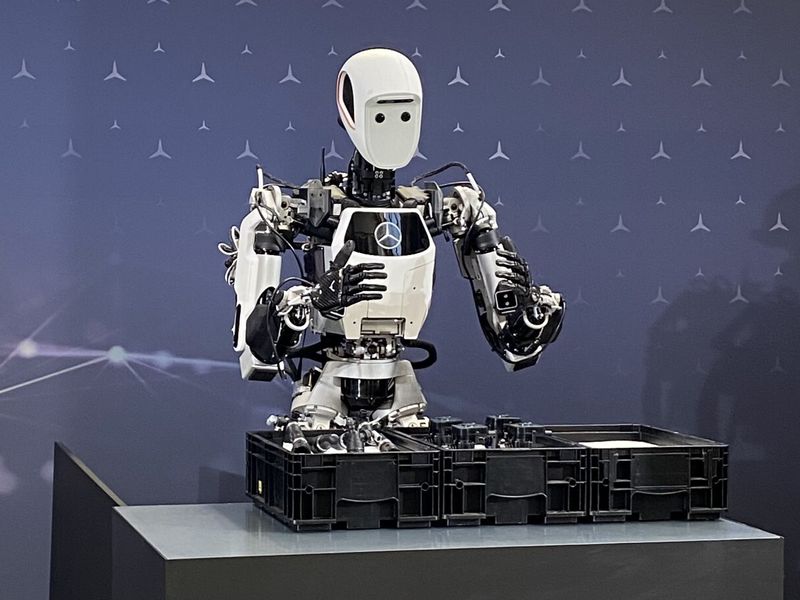
Tech by Android – Humanoid robots take retail jobs the debate in 2025 continues to ignite strong opinions on both sides of the aisle. Over the past year, thousands of retail stores around the world introduced lifelike robots as cashiers, stock clerks, and customer service agents. Advocates argue that robots improve efficiency, lower costs, and free humans from tedious labor. Critics warn about rising unemployment, depersonalized shopping experiences, and ethical concerns over replacing people with machines. The retail industry is transforming rapidly, forcing governments, workers, and consumers to rethink what the future of work looks like.
“Read More: Basic Principles of Radiation Protection and Personal Protective Equipment in Hospitals”
Retail chains began experimenting with humanoid robots as early as 2022. At first, they were deployed in warehouses to handle inventory and logistics. Success there encouraged companies to bring them into storefronts. By 2025, humanoid robots could greet customers, process payments, restock shelves, and even upsell products. Advances in artificial intelligence made their speech and movements increasingly natural. Many shoppers felt fascinated at first. But others felt uneasy seeing machines performing roles that once belonged to their neighbors or family members. This uneasy coexistence sparked fierce debate.
Proponents of humanoid robots in retail point to several clear advantages. Robots can work around the clock without fatigue, sick days, or breaks. They don’t require health insurance or wages. Their precision reduces errors in inventory and cash handling. Many retailers also highlight improved consistency in customer service because robots follow programmed protocols. For managers, robots promise higher profit margins by cutting labor costs significantly. Some consumers even appreciate the speed and efficiency of robot service during busy hours. Companies argue that the savings allow them to lower prices and expand operations further.
“Read About: The Impact of Android Gaming on the Traditional Console Market”
Employees displaced by robots often share a different perspective. Many workers have already lost their jobs as machines took over roles that supported their families. Retail jobs, while low-paying, often provide vital income for millions of people worldwide. Union leaders warn that replacing humans with machines erodes communities, deepens inequality, and leaves many without options. They argue that robots shouldn’t replace people outright but complement them in less desirable tasks. Workers fear a slippery slope where full automation could wipe out entire segments of the economy over time.
Shoppers themselves appear split on humanoid robots in retail. Some customers enjoy the novelty and efficiency robots bring. They appreciate faster checkout lines and fewer human errors. Others feel uncomfortable interacting with machines, particularly when it comes to sensitive questions or returns. Older shoppers often prefer human staff who can empathize and show understanding. In some surveys, people report that robots make stores feel colder and less welcoming. Consumer sentiment remains an important factor shaping how quickly robots will dominate retail spaces.
Policymakers have started drafting rules to manage the rise of humanoid robots in retail. Some propose taxes on companies that automate jobs, using the revenue to fund retraining programs. Others advocate for quotas limiting the proportion of robots in customer-facing roles. A few nations already require that retailers disclose when a customer is speaking to a machine rather than a human. The debate extends to privacy concerns, as robots equipped with cameras and microphones collect vast amounts of data. Balancing innovation with social stability remains a major challenge for governments everywhere.
Ethicists have raised deeper philosophical questions about replacing humans with humanoid robots. They argue that work provides dignity, purpose, and connection. When machines take over jobs entirely, society risks devaluing human labor. Some question whether it’s right to treat customers as mere transactions without personal touch. Others worry about creating a class divide where only a few benefit from automation while many suffer its consequences. These debates highlight that technological progress doesn’t happen in a moral vacuum but affects lives in profound ways.
Stores themselves have begun redesigning layouts to accommodate humanoid robots. Wider aisles and open spaces allow robots to navigate efficiently. Shelving and displays are adjusted to robot-friendly dimensions. Backrooms include charging stations and maintenance bays to keep robots operational. Some futuristic stores even remove traditional checkout counters altogether, favoring automated scanning and payment systems. These changes signal how deeply robots are reshaping not just the workforce but the entire shopping environment itself. Architects and designers now face the challenge of creating spaces that feel human despite heavy automation.
On the supply side, technology companies race to build the most advanced humanoid robots for retail. Startups and established giants alike are investing billions into research and development. Features like better facial recognition, more natural gestures, and emotional intelligence have become key selling points. Each new generation of robots pushes the boundaries of what machines can do convincingly. This intense competition drives down costs, making robots more accessible even for small retailers. But it also raises stakes for ensuring safety, security, and accountability as adoption spreads.
Some communities push back against full automation and explore alternative models. Cooperative stores owned by workers prioritize human jobs while still using selective technology to reduce drudgery. Others emphasize hiring and training local youth, viewing retail jobs as a way to build skills and community ties. In some regions, “human-only” stores have emerged as a niche attraction for customers who value personal service. These creative responses show that even as robots become more common, there’s still room for businesses that value people over profit.
What happens next remains an open question. Retailers, workers, customers, and governments will continue to negotiate the right balance between efficiency and humanity. Technology will keep improving, but whether society embraces or resists full automation will depend on cultural values and economic realities. As the debate rages on, one thing is clear: humanoid robots are here, and they’re transforming retail in ways few could have imagined just a decade ago.